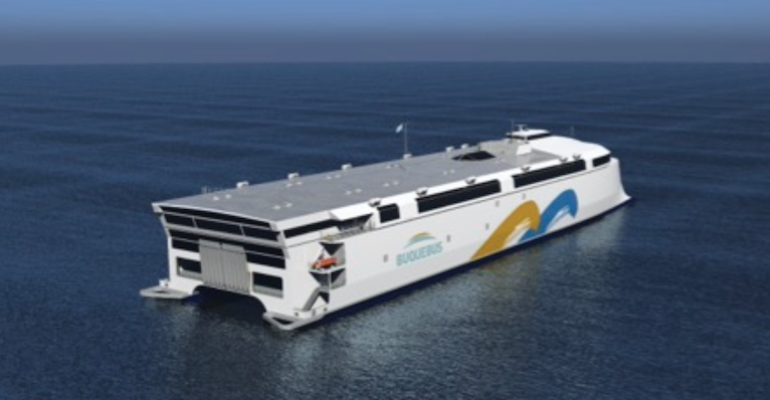The batteries will be supplied as part of the vessel’s Wärtsilä electric propulsion system.
The 130m aluminium ferry, with capacity for 2,100 passengers and 226 vehicles, will be deployed by Uruguayan ferry operator, Buquebus, on 45 nautical-mile voyages across the relatively shallow waters of the River Plate between Montevideo and Buenos Aires.
A key part of the ship’s design is the significant weight of about 500 tonnes saved by the battery setup rather than a conventional propulsion system.
The batteries, housed not in racks but one upon another in four battery rooms, will have more than 40 MWh of energy storage and provide power for eight water jets. The four-fold increase in capacity has been made possible by Corvus Energy’s four-year development of the Corvus Blue Whale Energy Storage System.
The company claims that the result is dramatic for marine battery projects owing to the low weight of the batteries and their high volumetric density. Even though these batteries, at 40 MWh, are four times larger than any current installation, Corvus is already working on systems of up to 100 MWh.
The batteries are a key component in the ferry’s power network which will be controlled by a Wärtsilä energy management system. The technology group will also supply DC shore charging systems, the DC hub, eight electric motors, eight Wärtsilä axial flow WXJ1100 water jets, and the ProTouch propulsion control system.
Halvard Hauso, Commercial Director Europe at Corvus Energy, commented: “This groundbreaking project marks a turning point in the maritime industry’s effort to transition towards greener means of transportation. Combining cutting-edge technology, environmental consciousness, and innovative design, it redefines the future of ferry operations worldwide and paves the way for other, zero-emission vessels.”
President of Wärtsilä’s Marine Power business, Roger Holm, said: “The overall efficiency of this next-generation ferry represents a game-changing advance in catamaran design. We are proud to have contributed our strong knowhow in integrating our ship electrification solutions and propulsion equipment. The battery power pack that we are supplying will be the largest ever supplied with a unique eight water jet propulsor configuration.
“The eight e-motor water jet propulsion configuration is the most efficient available on today’s market for this speed range and type application while boasting all the benefits from Wärtsilä’s axial flow water jet technology – low weight, shallow draught, superb manoeuvrability, and low maintenance,” he added.
Incat’s founder and Chairman, Robert Clifford, noted that his company had always been at the forefront of innovating and pioneering new technology and design and the project cemented this position. “The design addresses the market’s needs and requirements by utilising batteries, making it a very viable option for owners and operators looking to increase the sustainability of their fleets,” he said.
The project has dramatic implications for many ferry routes and short-sea trades around the world. Since the Buquebus operation will also depend on the highest capacity chargers to date, the development should also send a clear message to ports engaged in ferry operations and short-sea trades that high-grade shore power systems are now an essential component in shipping’s energy transition.
The battery systems are due for delivery at the end of 2024 and the vessel will start operations in 2025.
Copyright © 2024. All rights reserved. Seatrade, a trading name of Informa Markets (UK) Limited.
Add Seatrade Maritime News to your Google News feed.  |

